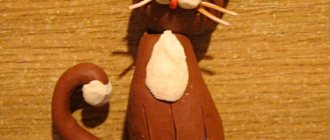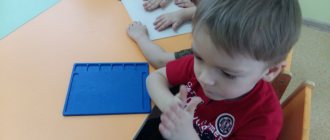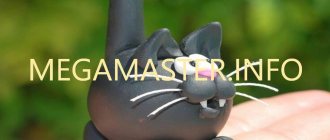How to make a fish from plasticine step by step
When planning to make a plasticine fish step by step, follow some simple recommendations. Key among them.
- If you are making sea creatures for the first time, start with simple options.
- Give your child more independence so that he develops imagination and fine motor skills while sculpting.
- Don’t try to combine many different shades – two or three colors are enough.
- Use a variety of objects to draw patterns on the body and fins of the fish - a toothpick, a cocktail straw, different sides of a pencil, and whatever else you have on hand.
- If possible, use soft plasticine that does not require careful kneading and heating during work. It is easier for a child to cope with it.
- All fish for children are made from simple geometric shapes.
- Don't worry if your child only sculpts with dark or light colors - this is normal.
- Use either ready-made eyes or make them from plasticine.
In general, sculpting fish is a fairly simple task. But children like it, it’s exciting for them to create funny little animals and decorate them in their own way.
A simple plasticine fish
Making angelfish is very simple. This work is suitable even for 3-4 year olds. Fish in two shades or made from “marble” plasticine will look especially impressive. The algorithm looks like this step by step:
- We roll a sausage out of plasticine, fold it into a loop - the fish with the tail is ready, all that remains is to decorate it.
- We slightly flatten the sausage, forming a body, make fins of any shape, attach them, create an eye from white plasticine and a pupil from black.
- The second option is to form fins directly from a rolled and folded sausage, and then just pinch it lightly at the top and bottom, and make the eye in a similar way.
You can make a mouth out of two balls or leave it as is.
The plasticine fish is ready.
Shark
If you decide to sculpt a formidable sea predator, then it is enough to prepare plasticine of two colors. Step-by-step algorithm.
- We sculpt the body into an oblong shape, and at the end we slightly narrow it.
- We apply a white cake, slightly extended onto the abdomen.
- We make the tail, fins and the main high fin from gray material.
- We form the mouth using a stack, carefully cutting it. Don't forget about the white teeth, trying to make them sharper. And we squeeze the nose part with our fingers for realism.
- We attach the tail to the back, and we also place the fins where they should be.
- If desired, you can make several small fins and attach them near the main one. We make the eyes from black plasticine and attach them to the sides.
You can make an impromptu fish house - an aquarium. Even if you add water, the product will not fall apart.
For another option for sculpting a shark from plasticine, watch the video:
gold fish
Children aged 3-4 years can already be trusted to make goldfish. It turns out cute, and the kids are usually delighted. You need plasticine, a toothpick and a glass stack.
- We form a large ball of yellow or orange plasticine.
- We roll the ball and then make a cake out of it. Using a stack, we mark a ponytail with two triangular tips.
- We trim off the excess so that the attachment point is round.
- Using a toothpick, we make a pattern - waves or stripes on the tail, and then attach it to the body.
- We also make the upper fin, forming a circle, a flat cake and a triangle from it. We carefully bend the part to make it more realistic, add a pattern and fasten it.
- Roll two small balls and flatten them.
- We attach the fins from below.
- Forming the eyes. They should be expressive and beautiful. Plasticine balls, which differ in color and size, will help with this.
- We roll two white balls and make a disk out of them, attaching them to the fish’s head. Then we make blue - this is the iris, and also attach it. The last one is a black icon. You can also add a small white highlight. We make a mouth using a toothpick.
That's all, the beautiful fish is completely ready.
Clown fish
Kids will love the clown fish. She is bright and interesting. It's easy to do step by step.
- Knead the orange plasticine, tear off a piece and roll it into a ball. Gently pull back one side to narrow it. You should get a “tadpole”.
- Lightly press the tip on one side and the other with your fingers. It turns out to be a tail. Using a toothpick, make not too deep lines, forming a pattern.
- Using white plasticine, make three or more sausages and flatten them until thin. Next, we wrap them around the fish to make a striped body.
- We use orange plasticine to make the side and top fins. By analogy, we draw an interesting relief with a toothpick.
- We attach the fins where they should be. All that remains is to make the eyes from plasticine or buy ready-made ones at a children's art store. We attach them to the head, draw a mouth and get a beautiful clown.
If you have a black marker, use it to trace the white stripes on the sea creature's body. This will add realism. The craft is simple, and a 5-6 year old child can easily handle it.
Swordfish
Another original underwater inhabitant is the swordfish. A plasticine craft consists of the following several stages.
- We use blue or gray plasticine for realism. Roll the crushed material into a ball. Next, we give it a natural shape so that the middle is quite large and the edges are narrowed.
- We make a cake from white plasticine, attach it to the belly of the future fish and distribute it well. Then we make the fin so that it is attractive.
- In front of the long nose of the fish, we make two indentations on the top of the body - there will be eyes. We make balls from white plasticine and place them in the recesses. We roll small balls out of black plasticine and insert them on top - these are the pupils.
- We form long side fins. They will have the shape of triangles. We fix each one on one of the sides. We make the edges uneven. You can use a stack to make notches.
- We form indentation lines on all fins of the sea creature.
Fish on cardboard
Your child will definitely love making a fish on cardboard. Everything is done quite simply.
- We take any paper base. We draw any fish, but so that it has clear contours. If you wish, you can take a finished printout.
- Using plasticine of the required colors, apply neat strokes taking into account the contour. You can make small balls rather than strokes - it will also be beautiful.
- We complement our fish with fins and eyes, trying to make everything beautiful. Decorations are available upon request. The result is a marine resident in an aquarium.
Modeling fish from plasticine based on a ball or ellipsoid
For children aged 5-7 years, you can offer to make a fish using an interesting technique. The base will be a ball or ellipsoid. The first option is easier to implement, the second is more difficult.
We proceed like this:
- Roll a ball or ellipsoid out of plasticine.
- We make a sausage from plasticine of a different color, slightly flatten it and attach it to the base on top. We cut the sausage with a stack and get the upper fin.
- Roll a ball or carrot out of plasticine, slightly flatten it and attach the tail to the fish. We make a pattern on the tail or cut it with a stack.
- We form two small balls and attach them from below - these are the lower fins. Using a toothpick or a straw, we form a pattern on the body of the fish.
- Using a toothpick or straw, we form a pattern on the body of the fish.
- Using the stack, we cut out the mouth or make sponges from plasticine. We form an eye from white and black material.
Funny fish are ready.
Modeling of angelfish fish from plasticine
The fish is quite complex, but it will definitely captivate the child. This will be an interesting activity.
- First we roll the ball and press it down. Next, cut out a square in a stack. And we divide it into two halves diagonally. These are two bases for sea angelfish.
- By analogy, we make two more triangles, but in a different color. This will be the ponytail.
- We attach the tails to the body on the wide side of the triangle.
- We decorate the fish using eyes, patterns, and strips of plasticine of different colors.








